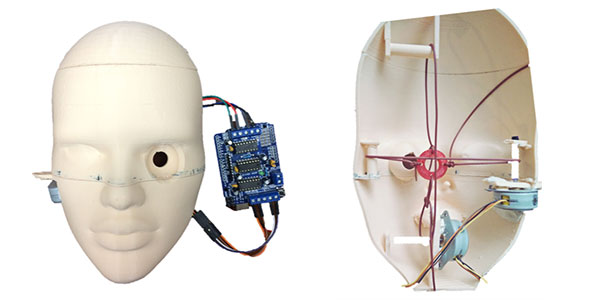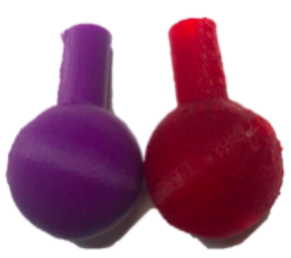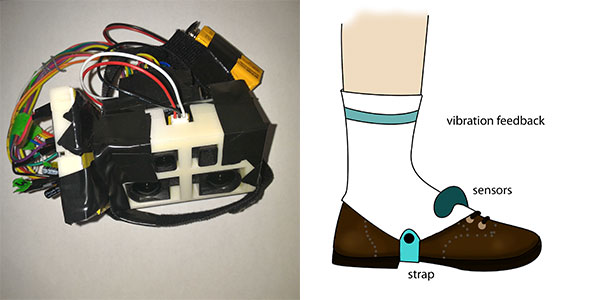A 3D-printed eye for ophthalmology training and a wearable device to detect tripping hazards for elderly patients are two top prototype biomedical devices created by U of T Engineering students this year. The projects grew out of the Innovation, Hammers & Nails Initiative, a collaboration between the Institute of Biomaterials & Biomedical Engineering (IBBME) and the Hospital for Sick Children (SickKids).
“The ‘nails’ are the challenges faced every day by clinicians, nurses, staff, and fellows at hospitals like SickKids,” says Christopher Yip, Director of IBBME. “The ‘hammers’ are the new devices, systems and solutions designed by IBBME researchers.”
Conceived by Dr. Christopher Caldarone, Chief of Preoperative Services & Surgeon-in-Chief at SickKids, Innovation, Hammers & Nails was launched in collaboration with IBBME in the Fall of 2015. Anyone from the hospital can propose a challenge that could benefit from an engineering solution, either through undergraduate design courses such as BME498 Biomedical Engineering Capstone Design, or through graduate theses and internships.
“Collaboration between clinicians and engineers is critical to the timely translation of ideas, concepts, or technologies to the bedside,” says Dr. Vito Forte, Professor & Program Liaison for Innovation, Hammer & Nails at SickKids. “With this program, we have been able to cement the natural bond that exists between IBBME and SickKids and work collaboratively to improve the delivery of care and patient outcomes.”
Learn more about the Innovation, Hammers & Nails Initiative
Here are two of this year’s top projects:

When Rachel Reding (Year 4 EngSci) was slightly late to a meeting at SickKids, it turned out to be a lucky break. “They had a patient coming in, and I actually got to see how they go through this whole procedure of doing an ultrasound diagnosis on the eye,” she says. “It gave me a better appreciation for how our project could help.”
Reding and her team — which also included Daniel Eftekhari, Jae Lee, Matthew Mazzuca, Sohrab Roointan and Mohammad Saleh (all Year 4 EngSci) — spent the fall semester in BME489 Biomedical Systems Engineering Design designing a new tool to help ophthalmology students practice eye exams and diagnosis.
“The training that they use right now involves doctors examining each other or healthy volunteers, which doesn’t really give them the chance to see the symptoms of eye diseases,” says Reding. “Our project was to create a simulation model.”

The team used a 3D printer to create a plastic human face and a series of removable eye models. When filled with water, the simulated eyes reacted to ultrasound in a very similar way real eyes. Printed physical features on the inside of the eye mimicked the telltale signs of various conditions: for example, a mushroom-like shape is indicative of melanoma. The model even featured a pulley system that could move the eyes left, right, up and down, allowing the user to focus on different parts of the eye.
Reding says that the feedback from researchers at SickKids was very positive. “A couple of the disease models need further refinement, but overall it was a really good platform to start from,” she says. Some of the team members plan to continue working on the project over the summer.
Reding herself will be starting a Master of Health Science in Clinical Engineering at IBBME next fall. “I would definitely say that this project influenced me to go in that direction,” she says. “I really enjoyed getting to work with some of the health care professionals and seeing how much of an impact we can make.”
Wearable tech to prevent falls

Physiology students Windy Wang, Yinyin Zhou and medical student Gabriel Keller originally wanted to design brain-machine interfaces to help people recover from stroke for their project in BME498 Biomedical Engineering Capstone Design. But after talking to medical professionals and stroke survivors, they decided to focus on a more common problem: preventing falls in the elderly.
“After a stroke, there is a very significant risk of having falls,” says Keller, a Brazilian exchange student in the Science Without Borders program. “This is also a problem for the elderly population in general, up to a third of which will have a fall.” According to Keller, falls are often accompanied by hip fractures or head trauma, which in turn can lead to further medical complications and loss of independence.
“About half of all falls happen because there is an obstacle that someone didn’t see,” says Keller. “As well, elderly people are also slower in terms of reaction time. We wanted to create something that would detect objects and provide an advanced warning system.”
The team’s device, called the OmniStep, is worn on top of an ordinary shoe. It uses a combination of echolocation and infrared sensors to detect when an object is in a person’s path. When it does, it provides a vibration to let the user know to be careful. In preliminary tests, the current prototype was able to detect objects higher than 30 cm with 90 per cent accuracy and smaller objects with about 75 per cent accuracy.
https://www.youtube.com/watch?v=IxcoJdnRSQI
One challenge the team faced was only providing the wearer relevant warnings. “If we detect something one metre from the floor, it’s tall enough for you to see, so we won’t alert you about that,” he says. The device is set to ignore taller objects like doors, walls and chairs, and it only provides warnings when the user is actually in motion.
OmniStep has been accepted into the IEEE Engineering in Medicine and Biology Society (EMBS) International Student Conference (ISC) 2016, to take place in Ottawa at the end of May.
Keller himself plans to spend the summer working on an asthma-related project at the Toronto Rehabilitation Institute before returning to medical school in Brazil next fall. “This project and the course in general strongly influenced me,” he says. “I have learned that biomedical engineering is a powerful and interesting way to help improve other people’s lives, and it can be really fun too.”




